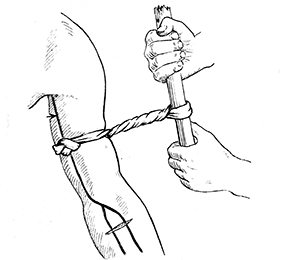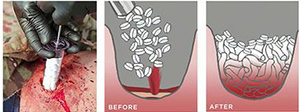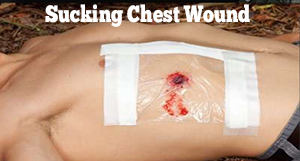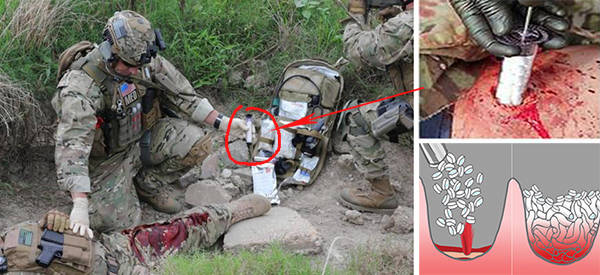A gun is the most effective and easily available weapon, so in a disaster scenario, it’s obvious that gunshot wounds pretty frequent.
Some types of gunshot wounds can even be healed with home resources, but most of them need to be treated by a medical professional and with hospital resources. But for all gunshot wounds, first aid is essential for survival and complete healing!
What Should Be Done First?
The first step is to make sure both you and the victim are safe. If you are going to be injured too, you won’t be much of a help!
Unless the victim is shot in the arms or legs, it’s preferable not to move her. All gunshout wounds in the head, neck, chest, or abdomen have a great potential of spinal injury, and moving the victim could cause additional damage to the spine. However, if your location is too exposed and it puts you both in danger, you can consider moving the victim to a safer place.
It’s always a great idea to use latex gloves when dealing with open wounds, for your protection. If emergency numbers are still available, call them! Most gunshot wounds require prompt interventions from a medical practitioner, preferably a surgeon.
Gunshot wounds always cause a great deal of tissue damage, so bleeding is usually heavy. You need to control the bleeding in order to give the victim a chance to survive. You can use any type of cloth to put pressure on the wound with your palm. Apply steady pressure for at least 10 minutes without moving too much. If the cloth becomes soaked, just add another one on top of it. Never remove the soaked bandage, because doing so would only make the bleeding start again.
If the victim was shot in an arm or leg, there is a great chance that a large artery was damaged. In an arterial hemorrhage, the blood is bright red and flows with pressure, following the rhythm of every heartbeat. An arterial hemorrhage is especially dangerous because it causes massive blood loss in a very short time, and it’s harder to stop than venous damage. The increased pressure of the arterial blood makes the clotting process more difficult. This is when you must consider applying a tourniquet.
 A tourniquet can only be applied on the arms or legs. NEVER try applying one on the neck of the victim!
A tourniquet can only be applied on the arms or legs. NEVER try applying one on the neck of the victim!
Write down the exact hour when the tourniquet was applied. Keeping it on for more than 30 minutes at a time could result in severe tissue damage and necrosis. An emergency tourniquet can be improvised from any kind of thin strap and is always placed proximal to the site of hemorrhage. For instance, if there’s a bleeding wound in the ankle, the tourniquet must be placed below the knee.
Applying a tourniquet in a correct, effective manner means more than just tying a piece of cloth around a man’s leg or arm, so you should learn how to make one.
A pressure bandage is also very important in controlling the bleeding, so you should be able to apply one of these as well.
 Another extremely effective way of controlling the hemorrhage is by inserting XSTAT in the wound (see image). They absorb very well and increase volume, applying pressure on blood vessels and helping the hemorrhage to stop.
Another extremely effective way of controlling the hemorrhage is by inserting XSTAT in the wound (see image). They absorb very well and increase volume, applying pressure on blood vessels and helping the hemorrhage to stop.
Most people with gunshot wounds go into shock. It’s important to be prepared for that. Heat loss should be minimized, so you should use any available resources to prevent the victim from getting cold. Normally, if a victim is in shock, her legs should be elevated in order to maintain blood flow to the brain and other vital organs situated in the upper body. But don’t elevate the legs of a gunshot victim who has a spinal or a thoracic injury!
What’s Next?
If an emergency team is on its way, the hemorrhage is under the control, and you and the victim are in a safe place, you can just wait while reassuring the victim. However, if emergency care is not available, you should take additional steps in treating the wound.
You need to carefully look for an exit wound or for any other wounds on the victim’s body. The exit wound shows you the trajectory of the bullet and indicates what other organs might be damaged.
If you are dealing with an arm or leg wound, just control the bleeding, apply a pressure bandage, and rush the victim to a safe, warm place, where you can clean the wound (carefully, to prevent it from bleeding again) and give antibiotics to fight infection.
Related: The Only 4 Antibiotics You’ll Need when SHTF
 If you are dealing with a chest wound, there isn’t a lot you can do. A bullet chest wound is also called a sucking wound because air is coming in through the wound, causing lung collapse. A sucking wound is easy to recognize since there is a specific sound: The victim coughs up blood, and there’s a shortness of breath.
If you are dealing with a chest wound, there isn’t a lot you can do. A bullet chest wound is also called a sucking wound because air is coming in through the wound, causing lung collapse. A sucking wound is easy to recognize since there is a specific sound: The victim coughs up blood, and there’s a shortness of breath.
You need to find the wound and check if there’s an exit wound as well. If there is, they both need to be treated. You need to seal the wound using some airtight material and taping it around the wound. Plastic is the top choice, and it should be taped on all sides, except for the bottom corner—that’s where air will escape. While sealing the wound, ask the victim—if still conscious—to exhale and hold their breath so much of the air is forced out before the wound is sealed. Then apply steady pressure on the wound and monitor breathing.
An abdominal gunshot wound can be equally as dangerous as a chest wound. If the bullet damaged the liver or spleen, there isn’t much you can do to control the bleeding. Pressure on the wound can help, but sometimes it’s just not enough. If the intestines are damaged, a severe infection will occur and will probably not subside unless surgery is involved to fix the intestinal walls and prevent them from leaking. However, since it’s not over till it’s over, the best thing you can do is to prevent the victim from taking anything by mouth. They should not even drink a sip of water—this is crucial in order to give the victim a chance to survive! The next thing to do is find a doctor that can treat the abdominal damage.
Despite what you might have seen in movies, removing the bullet is almost never a good idea. It will just cause more bleeding, and you will most probably be unable to find it without an X-ray. There are hundreds, even thousands, of veterans that have metal projectiles or projectile fragments in their bodies, and they don’t cause any serious problems.
You may also like:
 Some Firearm Tips for Those Who are New to Firearms
Some Firearm Tips for Those Who are New to Firearms
Do You make These Fatal Mistakes in a Crisis? (Video)
How Much Does it Cost to Bulletproof Your Car?
How Much Does a Nuclear Bunker Cost?
24 Lost Survival Tips from 100 Years Ago – with Illustrations












Great, but according to manufacture it may never be available the public.
That’s probably a good idea since there are many contra-indications for use.
“A tourniquet can only be applied on the arms or legs. NEVER try applying one on the neck of the victim!” I am really scared if you have to say this! Maybe Darwin could have said it in a different manner!
Farmer, as a former paramedic, you would not believe the things that people do in the lines of thinking they would help the patient.
Every cliche you’ve seen in the movies about helping someone out, has been tried. sucking the poison out of a snakebite, tourniquets around places other than arms and legs, and there are only a couple of places that a tourniquet could be left to apply, just use your imagination.
But yes, the disclaimer should and probably legally needed to be included because people in a crisis often don’t think straight and will do things that will in the end cause harm to the patient.
I believe you … but I’m still afraid for the human race.
No, this is a rather jaundiced view, but I think we have really dumbed down our race with all the protections we put in place so that children can’t get hurt. I think in bygone centuries the really clueless ones died early in childhood. One reason why life expectancy was so low wasn’t that people didn’t live as long as now, it was because many people didn’t make it out of childhood. They died of disease or injury, injury caused by failure to observe common sense. I think in an EOTW scenario, once again, the folks with common sense will survive and the ones without will not and as a consequence we will see a hardier, more cogent human race.Well, maybe that is not jaundiced, maybe it is pollyannish.
I like the common sense of the article. As a Prepper of many years, and a EMT of 43 years, and an EMS Instructor of 33+ years, I offer classes in what to do if the SHTF and there no Ambulances, Hospitals, or Doctors available in a Trauma/Medical emergency. If a person can not find a “Field” emergency class, you should be able to get several good reference Medical books covering Medical Emergencies, Trauma, Diseases, from simple care to more complex situations. BE PREPARED, just incase.
I too am a former EMT-A and later a18 D with several decades in the trenches. As far as the time you can leave a tourniquet on, In Iraq and Afghanistan it was found a properly applied tourniquet can stay on for hours and in one case I was involved with 12 hours was the time line and the trooper did not loose their limb. I used a B/P Cuff as my tourniquet. The old stop bleed material caused a lot of damage due to heat and it adhering to the tissue which the doc had to cut all that material out of the wound channel. Don’t buy surplus blood stop. They now have the blood clot syringe with a blood clot material in it and you can fill the wound channel with this clotting material. Not always, but it has stopped blood lose that you normally would never been able to do in the past. I always carried racket and tennis balls in my kit for groin and arm pit injuries. Put in blood stop/dressing/ball and tourniquet. The ball will conform to odd angles and apply pressure to vein or artery and help stop bleeding. A good class is always a good way to keep you and yours safe and alive.
Best Regards,
Ranger Rick
North Idaho
Ranger Rick, how is the racket used – to what type injury do you apply that?
He was referring to racquet balls smaller than tennis but larger and after than a golf ball
Female Sanitary pads make excellent bandages….in fact they were originally made for bandages and then developed into female sanitary use.
They are sterile until opened….
UNSCENTED tampons that are unopened are sterile and can be use to “plug” bullet wounds but must be removed by a doctor…or someone capable and ready that is prepared to deal with serious wounds.
Tampons should not be used to plug a penetrating wound. All you are doing is pushing all the debris and dirt around the entrance of the wound deeper into the wound subjecting the patient to possible septicemia from bacteria and other infectious material pushed deeper into the body.
While tampons, perhaps, may have been used in the field by Navy corpsmen or Army medics, they knew the dustoff helicopter was en route and the patient would be soon in a fully equipped field hospital treated by trained professionals and the wound channel irrigated with sterile saline solution with a full course of antibiotics to follow.
In an EOTW situation or in the field where such treatment may be hours or days away, pushing contaminating material in with a tampon is contraindicated. Applying pressure with sterile 4×4 pads is far better than shoving tampons into the wound channel.
It isn’t the cleanliness of the tampon that is in question, it is the cleanliness of the entrance and first few cm of the wound channel that is questionable.
Is there any truth to the legend that you’re sometimes better off to leave the bullet in? I heard they actually killed President McKinley while removing the bullet rather than the wound itself.
I don’t know about McKinley, but I read a book about President Garfield. He died of overwhelming septicemia which the book alleged was caused by the pompous a.h. of a doctor who, looking for self-glory, probed Garfield’s wound with his unwashed finger, trying to extract the bullet. The author of the book stated that many Civil war vets carried bullets around with them the rest of their lives because surgery of the time could not remove them. It was the author’s posit that the likelihood of Garfield surviving the wound itself was quite good except for the so-called “doctor” who “treated” Garfield by sticking his finger in the wound.
Forget about removing bullets!
It is always better for the first aider or field medic to leave the bullet alone. Movies and TV shows are terrible sources of medical information. On TV, doctors frantically search for the in-bedded bullet, and only when it is removed does everyone breath a sigh of relief. This is nonsense. Removing the bullet rarely improves the patient’s condition, and attempts to remove them in the field frequently cause greater injury and more severe bleeding. DO NOT EVER ATTEMPT TO REMOVE BULLETS OR SHRAPNEL IN THE FIELD!
As for President Kennedy, no attempt was made to remove bullets. A large portion of the Presidents skull and brain had been pulverized by the rifle bullet, making survival impossible and the location of any remaining bullets or fragments irrelevant. However, even if survival had been possible, removing the bullet would not have been a priority because the doctors know that removing bullets is almost never an urgent matter. In fact, bullets are sometimes left in the patient’s body even after they have recovered because, unless it is lodged in a location where it might erode a nearby organ, removing it is usually unnecessary. There are many people walking around with bullets or shrapnel fragments still lodged in their bodies.
As a retired nurse I decided to check up on that X-Stat mentioned. This type was not in general use when I was working, we had long strips of absorbant material that could be packed into wounds to slow bleeding. X-Stat sounds better but I can’t afford to pay $299.99 for one applicator full of sponges. I’ll opt for a large pack of sanitary tampons and pads, and take my chances.